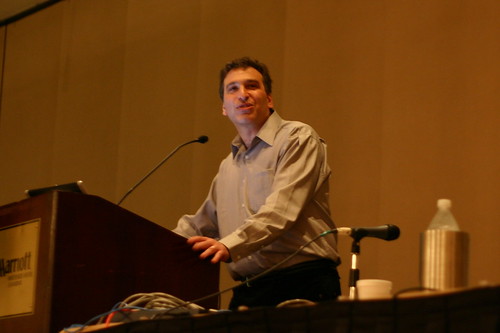Beyers Sellers, Professor at Johnson School at Cornell University and host of the popular "Metanomics" talk show in SL, gave a really neat keynote address on “Why Johnny Can’t Rez.” Beyers addressed the difficult issue of how to convince your higher-ups and colleagues to support your virtual education project. It was a nice capstone to the addresses by Intellagirl Tulley and Barry Joseph on education in SL. Beyer’s main message was that to get your administrator to release the pursestrings to fund your virtual world education project, you need to help them fulfill the goals of the institution.
My notes on Beyer’s talk follows…
Beyers described the three basic questions to answer for your administrator are:
- How does this help me accomplish my goals or the goals of my institution?
- Why are VW’s the best way of accomplishing those goals?
- What are the costs and risks?
1. How does this help me accomplish my goals or the goals of my institution?
It’s important to frame your approach based on the goals of your administrator. Get the documents that frame the institutional goals, get the history of that process, and find out what the administrator wants to do personally.
2. Why are VW’s the best way of accomplishing those goals?
What is it that VW’s are particularly good at in comparison to competition (i.e. a RL classroom, another online solution). I have identified three:
a. Presence in Place:
- SL offers synchronous communications with presence. Avatars provide for a lot of non-verbal communication.
- You can pitch this to a marketing dept well. VW’s are closer to a personal connection. They allow people to share an appearance.
- Example: At my institution, we have an interest in connecting them to the space of the campus. SL is good at accomplishing that.
- Example: Another group working on a “Virtual Congress” : replicating the Congress building, congressional offices and K Street where all the lobbying happens.
- Serendipity: the possibility that someone might be in the same space as me and we meet. That won’t happen in a webinar.
b. Constructive Cacaphony
- SL provides many avenues of communication and they can all happen at once. This can be overwhelming, but also very rich: i.e. speaker to audience, audience to speaker, IM, public chat, links, etc.
- This has the potential to make the virtual experience BETTER than real life.
c. Creative Collaboration
- SL offers possibilities for collaborative work that is unique and powerful. I.e. avatar creation, machinima, games creation.
- Example: Wikitecture : collaborative architecture
- Example: Peggy Sheehy’s work on narrative
3. What are the Costs and Risks?
It is very unlikely that your VW project is going to be mission critical to your institution. It’s likely to be extending something that you already do, but doing it better or cheaper. You want to argue that it is cost effective and not too risky.
Costs:
- In a virtual conference, we found that the organizer wasn’t going to save a lot of money compared to a physical conference. Conference organizers typically pay for the room, food, drink, etc.
- Where are the savings? Largely in eliminating airfare and hotel costs, which helps the attendees, not the organizers.
- Going to a virtual conference entails costs. It might involve bringing people into a VW. The organizers need to support these people to get them to come to your conference.
- We need to make the case to everyone: the organizer, the speaker and the attendees. And we need to shift those costs around in ways that make sense.
- You can also argue the environmental cost of a conference – more green, responsible.
- For international conference an SL conference becomes more attractive
- Focus on educational projects that you can do over and over that rely upon the same resources. Do not just one conference but a series of workshops, courses, or meetings. So you can reuse resources.
Risks:
- Tech Can Be Unreliable – we have redundancy built in to any tech that we use.
- Inappropriate Behavior – lock down your sim if you have concerns about how certain attendees will behave.
- Risk to Reputation — You can insist on dress codes, behavior rules, etc. IBM has great policies about this.
Recommendations for reducing perceived risk:
- You don’t have to use the name “Second Life” right up front, which can have negative connotations for some administrators. Use a term like “a synchronous immersive online environment.”
- Let decision makers get familiar with virtual environment in a controlled way. Show successes that others have had. Get them inworld in low risk settings.
- Pull off a small project that provides a short term win.

Great post! Thanks for this 🙂